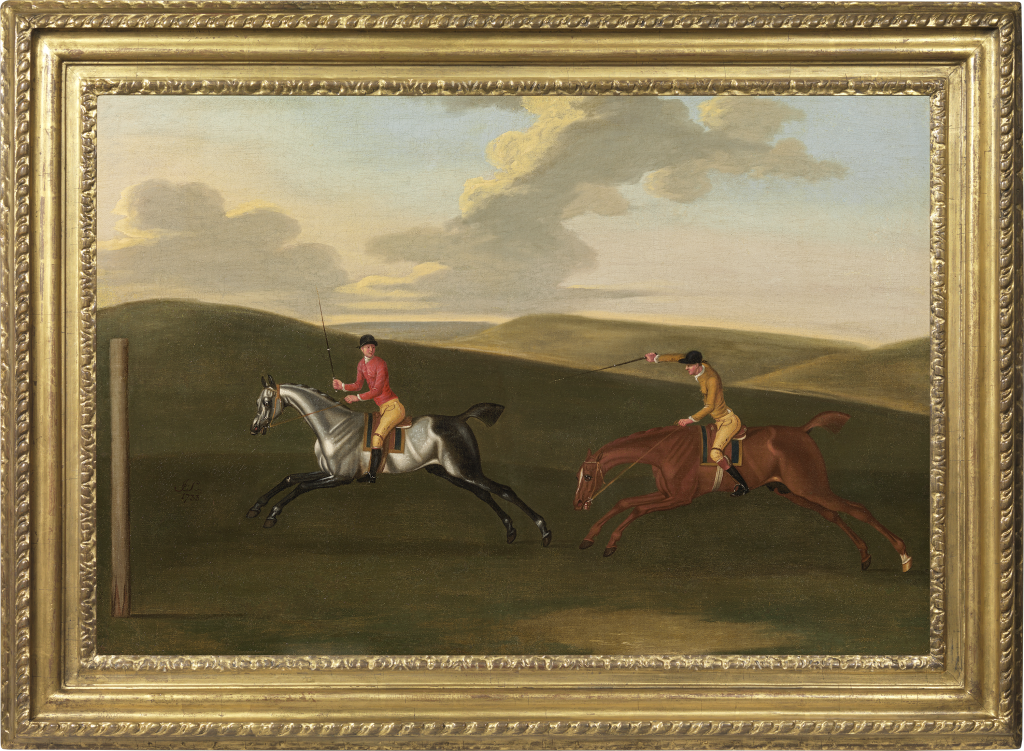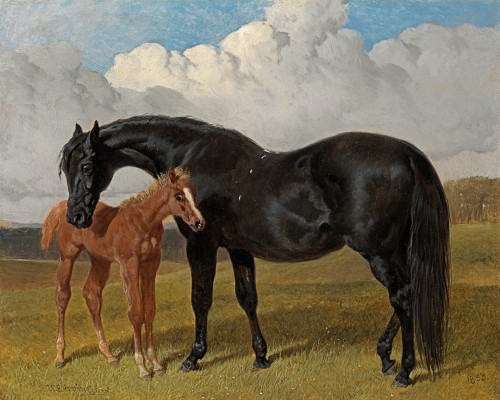JAMES SEYMOUR
Circa 1702 - London - 1752
Ref: CA 158
A Match on the Downs with a grey beating the Duke of Bolton’s chestnut
Signed with initials and dated lower left: JS / 1733
Oil on canvas: 24 3/8 x 36 in / 61.9 x 91.4 cm
Frame size: 31 ½ x 42 in / 80 x 106.7 cm
Provenance:
Sackville Pelham, 5th Earl of Yarborough (1888-1948) (label on the reverse of the frame)
Arthur Ackermann & Sons, London;
private collection, UK;
Sotheby’s London, 29th November 1978 lot 113;
private collection, UK
Literature:
Richard Wills, James Seymour 1701-1752, p.156, no.30, illus. in colour
A grey horse gallops towards the finishing post, trailed by a chestnut whose jockey wears the colours of Charles Powlett, 3rd Duke of Bolton (1685-1754). The scene is probably the Hog’s Back on the North Downs near Guildford; there was a racecourse at the village of Merrow from 1701[1]. Seymour painted very few Matches, contests between two, or sometimes three, horses for which each owner provided a prize purse. He captures the energy and speed of the horses, the excitement of the jockeys and the sweep of the downland landscape, with clouds spiralling up into a pale blue sky.
Seymour had a circle of clients with connections to the Guildford and Epsom racecourses; the 3rd Duke of Bolton’s seat was not far away at Hackwood Park, Hampshire. He painted a portrait of the Duke out shooting circa 1740 (Government Art Collection, on loan to the Royal Armouries, Leeds) and The stables and two famous running horses belonging to His Grace the Duke of Bolton, 1747 (Paul Mellon Collection, Yale Center for British Art, New Haven, CT)[2]. The Duke followed his father the 2nd Duke, owner of the celebrated Bay Bolton, in being an aficionado of the Turf. A Whig politician who served in the cabinet of Sir Robert Walpole, the 3rd Duke of Bolton is most renowned – or notorious – for his twenty-three-year relationship with the actress Lavinia Fenton, whom he finally made his second Duchess in 1751. Lavinia had sprung to fame as Polly Peachum in John Gay’s satire on Italian opera (and on Walpole’s corrupt government), The Beggar’s Opera (1728). In William Hogarth’s painting of The Beggar’s Opera (1731; Tate Britain, London), Lavinia/Polly pleads for the life of her lover, highwayman Captain Macheath, while gazing towards her real-life lover, the Duke of Bolton, who sits in the audience.
William Hogarth, The Beggar’s Opera, 1731. Tate Britain, London.
The 3rd Duke of Bolton (far right, in blue) watches his lover Lavinia Fenton play the part of Polly Peachum.
JAMES SEYMOUR
Circa 1702 - London - 1752
James Seymour was born in London, the son of a banker, goldsmith and diamond merchant, who supplied plate for racing trophies. Seymour’s father was an amateur artist, a member and, in 1702, a Steward of the Virtuosi Club of St Luke, to which John Wootton and Peter Tillemans also belonged.
Seymour began to draw at an early age and studied pictures and prints in his father’s collection. In 1720 he attended the art academy in St Martin’s Lane founded by Louis Chéron and John Vanderbank; the raffish Vanderbank became a friend. Encouraged by his father, he received introductions to the leading artists of the day. Seymour developed a passion for horse racing and is believed to have owned racehorses. He was among the first English painters to specialise exclusively in sporting subject matter. In 1739 the Universal Spectator declared that Seymour was ‘reckoned the finest draughtsman in his way [of horses, hounds etc.] in the whole world’. George Vertue noted his ‘genius to drawing of Horses’, as well as his life as a young rake: ‘the darling of his Father run thro some thousands – livd gay high and loosely – horse raceing gameing women &c.’ (Note books, vol. III, p.86). Seymour’s prolific output in paintings and sketches belies this portrait of indolence.
Among Seymour’s patrons were the banker Peter Delmé, John Jolliffe, MP, the 3rd Duke of Bolton and the 6th Duke of Somerset. He was commissioned by the latter to decorate a room with portraits of racehorses; however, they quarrelled and the project never materialised. Many of Seymour’s racing, hunting and stable scenes were engraved, among them Twelve Prints of Hunters and Running Horses (c.1750) and thirty-four racehorse portraits (1741-54). According to Vertue, the latter part of Seymour’s life ‘was spent in the lowest circumstances of debt’ (op. cit., vol. III, p.86). He died unmarried in Southwark on 30th June 1752.
The work of James Seymour is represented in Tate Britain, London; the Yale Center for British Art, New Haven, CT and the Virginia Museum of Fine Arts, Richmond, VA.
[1] We are very grateful to David Oldrey for the identification of the location and to Richard Wills for further information.
[2] Judy Egerton, British Sporting and Animal Paintings: The Paul Mellon Collection, London 1978, pp.46-47; pl.18.




























